On 30 June, 1827, an enormous crowd gathered in the streets of Paris, understandably so, for the sight they beheld was quite unusual. For the first time ever, towering high above the people, there was a giraffe in Paris. Nicknamed ‘Her Highness’, the giraffe was a gift from the Egyptian Pasha Mehemet-Ali to Charles X, the King of France. Taken from her mother (who was killed in the attempt) as a two month old calf in Sudan, the giraffe began a journey that would last several years, from Khartoum to the port of Alexandria and across the water to Marseille. She was immediately a public sensation. But how was a giraffe to meet her king in Paris, almost 800 km away, and with winter approaching?


A Giraffe in Paris
Suitably covered in her warm winter coat, with 3 cows specially bought from Egypt to supply the 20 to 25 litres of milk she needed per day, Her Highness spent six months in Marseille. In May 1827, she began the long walk to Paris wearing a specially made black raincoat to cope with the wet spring weather. Thousands of French lined the roads to view this amazing spectacle, accompanied by her police guard and other exotics animals sent over from Egypt. Thankfully, the royal giraffe arrived in Paris largely without incident, having spent 41 days on the road. Her Highness was delivered to the Jardin des Plantes, where she was to become an extremely popular exhibit in the menagerie; more than 600,000 Parisians supposedly jostled for space in the first few months to catch a glimpse of the giraffe.
A mania for all things Giraffe soon took over all of Paris.



And did the king like his gift? Despite having complained that he would be the last Frenchman to see his own giraffe, and wanting to meet her on the way he was advised to ‘act like a king’ and make the giraffe come to him. Therefore la girafe was roused from her bed a mere nine days after her arrival and sent on her way to be presented to Charles X at the royal Château Saint-Cloud on the outskirts of Paris. History does not record his response, but Her Highness frolicked in style in the gardens of the château and sampled several choice rose bushes.
The King’s Garden
Charles X had sent out a request several years earlier for exotic animals and birds to populate his menagerie at the Jardin des Plantes. This royal botanic garden, Le Jardin Royal des Herbs Médicales, was founded in 1626 as the king’s medicinal garden and had been first opened to the public in 1650. It was created to further scientific research, and was answerable only to the king, who was Louis XIII at the time. It was not until almost a century later that the garden, now renamed simply the King’s Garden, would flourish due to new and important expeditions to foreign lands.
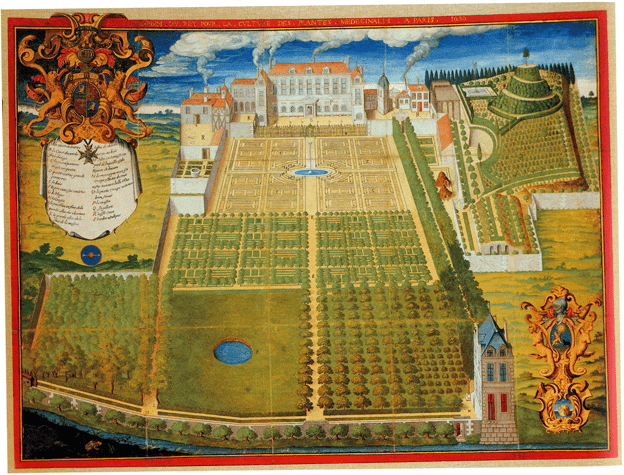
Coffee beans had been introduced to the south of France in 1644 and the worldwide trade began to flourish. The Sultan of Yemen gifted 60 coffee plants to Louis XIV which were immediately planted in the gardens of the newly built palace of Versailles, and later in the ornate light-filled hothouses which were specially built for studying tropical plants in the King’s Garden in Paris. In 1720 a cutting from one of the king’s coffee plants was carefully nurtured all the way across to the French colonies in the West Indies, where captured slaves worked in terrible conditions on the islands of Martinique, Guadelupe and Saint Domingue to establish enormous French coffee plantations.
Read more here about the history of coffee in Paris
Jardin des Plantes
With the French Revolution, a new scientific era and quest for knowledge was begun. The garden was renamed Jardin des Plantes and its immense glass and cast iron greenhouses were filled with exotic plant specimens from all the world. Many of these came from Napoléon Bonaparte’s quest to dominate Europe – his 1798 military expedition included over 150 savants or scholars, such as botanists, astronomers, archaeologists, chemists, and artists. The drawers of the Museum of Natural History at the Jardin des Plantes are today filled with the thousands of animal and botanical illustrations from this expedition.
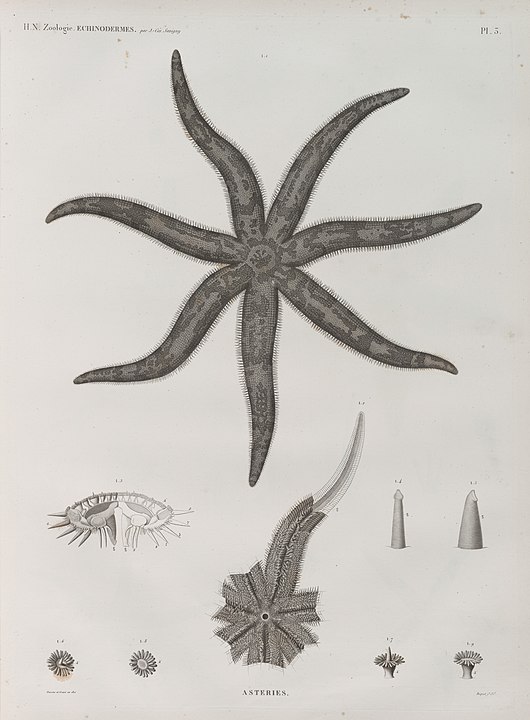
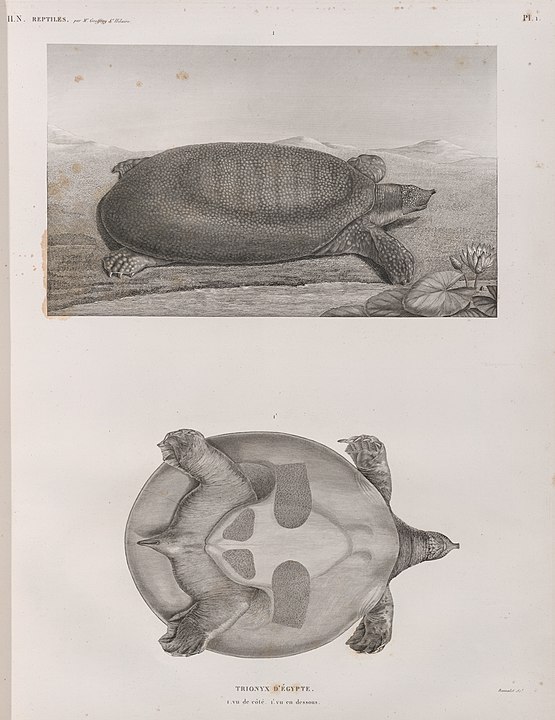
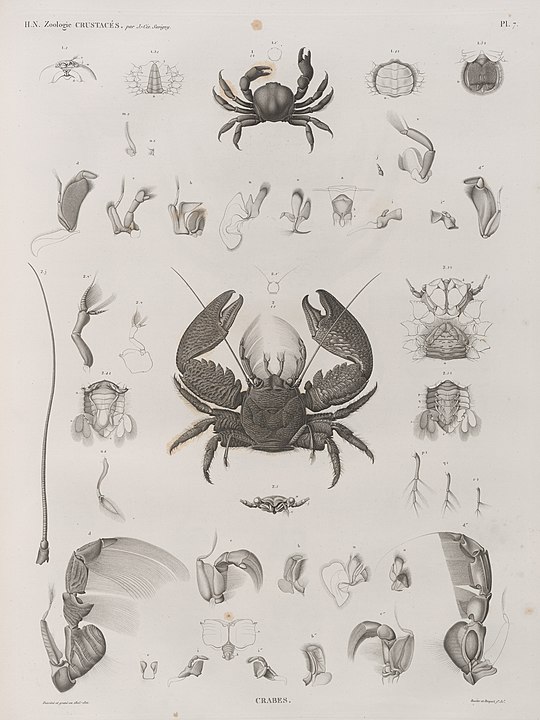
Across the seas to Australia
In 1800, ambitious explorer and naval officer Nicholas Baudin set sail For New Holland, newly settled by the British. With two ships, the Géographe and the Naturaliste, and an unprecedented number of botanists and naturalists (there were 22), the expedition planned to explore the coastline and bring to France all manner of ‘undiscovered’ plants and animals. They returned triumphantly three years later, ships stuffed to the sails with over 200,000 exotic specimens for the Natural History Museum. This included hundreds of live plants such as Australian myrtles, acacias and eucalypts and over 600 species of seeds. As well as preserved specimens including 40 new species of butterflies, lizards and tree frogs, live animals were included on the ships, with black swans, a lyre bird, wombats, dingoes, parakeets, a long-necked turtle, an emu and a platypus. There were kangaroos and wallabies of course, who were granted VIP status when some of the botanists were evicted from their rooms in order to give the ‘roos a more comfortable space to finish the long and arduous journey.
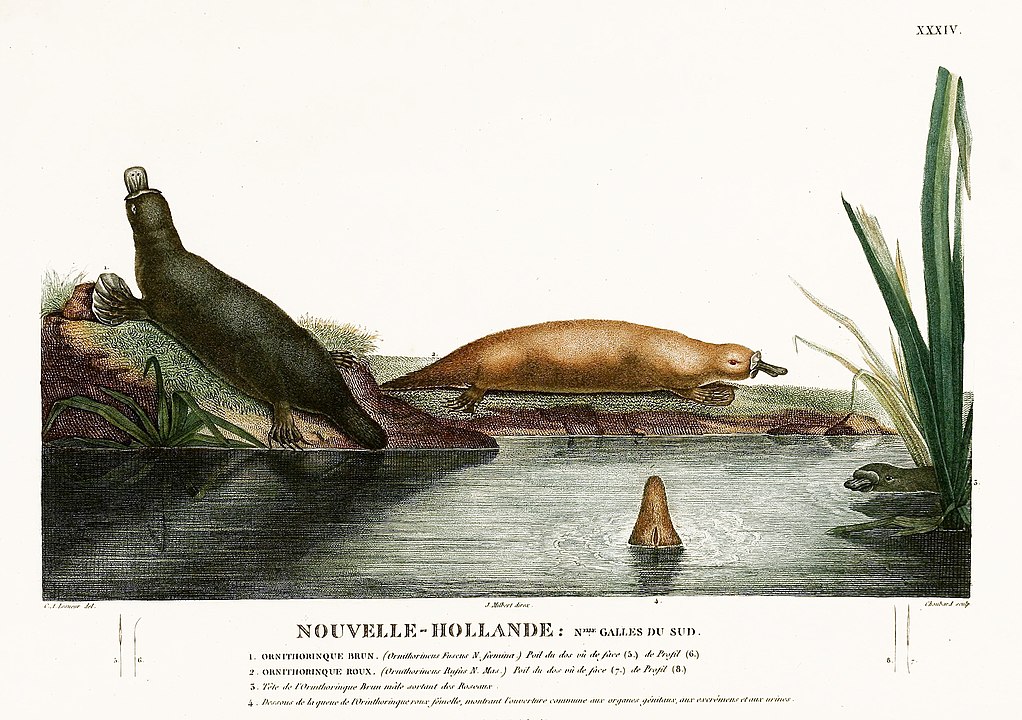
Many of the collected plants and animals from this expedition made their way to the enchanted gardens of Malmaision, where the Empress Josephine, wife of Napoléon, had made her home: lions, panthers, ostriches, porcupines, deer, monkeys, mongooses, tortoises, a zebra, a hyena and a gnu from the Cape, South Africa. And of course, more roses for her beautiful, burgeoning collection.
Related post: 5 Places to Smell the Roses in Paris
As the 19th century meandered on, the menagerie at the Jardin des Plantes continued to grow. Not only did they have their Australian fauna, there were also the five animals who had been rescued from the zoo at Versailles following the execution of Louis XVI and Marie Antoinette, including a lion and a rhinoceros, and performing animals removed from the streets of Paris to a safer place. By the middle of the century the elegant menagerie housed not only Her Highness, the first giraffe in Paris, but elephants, bears, birds of prey, monkeys, antelopes and pheasants.
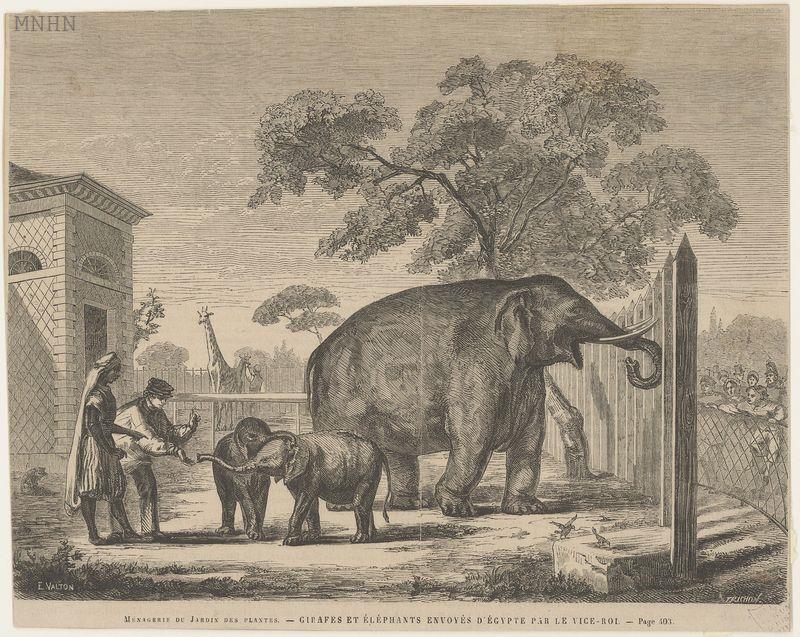
The elephants of the Jardin des Plantes, at Paris, have, by comparison with the elephants of our close menageries, a life of much happiness. Their cells are spacious; they are let out, at particular periods, to range about a large enclosure; and they have a bath which they enjoy with infinite delight in warm weather. We saw, in 1825, the large male (who is since dead) up to his middle in a pool, in a hot day in August, spouting the water from his trunk with scarcely less joy than he would feel in his native woods. When his bath was finished, he would stand quietly for a little time in the sun;-and then, gathering a quantity of dust in his trunk, blow it over his back till the crevices in his skin were sufficiently covered to be protected against the flies.
Charles Knight, 1831
Galigani’s New Guide to Paris, 1852
The Jardin des Plantes and its menagerie were unmissable sites on the tourist trail in 1852.
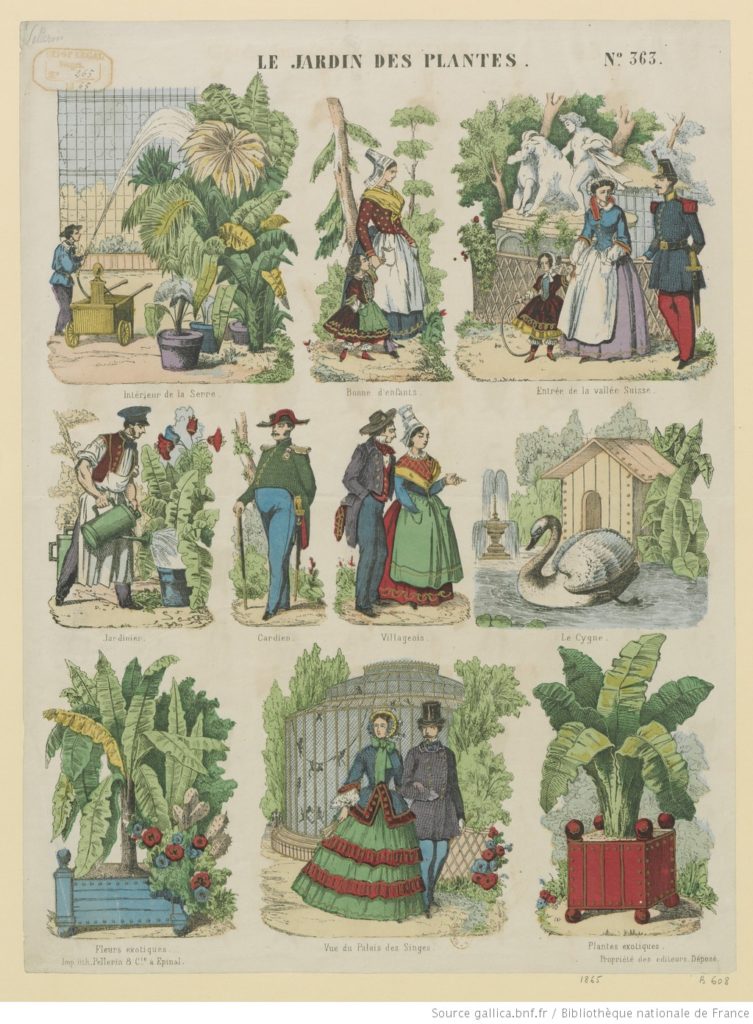
Here is what you would have read in the fashionable travel guide by Galigani in 1852:
In the first enclosure near the above entrance is a flock of llamas; that flanking the orangerie contains sheep from Tibet and other countries. The following one to the left is devoted to varieties of the goat and antelope species. Contiguous to this is a spacious poultry – yard with numerous species of fowl, geese, swans, peacocks, cranes, & c . To the right is a polygonal building, by railings. Here are two elephants, three camels, a cabiaï or capybara from Brazil, and a young rhinoceros. Of these the elephants are the most sociable, and upon the best terms with the juvenile public that daily visits them. The adjoining enclosures to the right are occupied by several of the deer species, and next to these are three sunken paved courts with cells, where three black bears and a white one afford much amusement to the crowd. Taking the polygonal building mentioned above as a land mark, the stranger will find to the left, and contiguous to the poultry – yard, another enclosure, where, besides storks, swans, and other fowl, a càssowary and two ostriches are kept in different subdivisions. Next is a graceful semicircular pheasant house, divided into spacious cages, containing numerous varieties of that tribe. Adjoining, in a small enclosure, is a colony of tortoises, and opposite is another for the ass and zebra tribes. Behind the pheasant – house, and beyond the railing which surrounds the menagerie, there is also a kind of hot – house, where live snakes and other reptiles of southern climates are kept in glass cages, and protected by blankets from the cold. Following the path to the left, contiguous to the tortoises, we come to the roliere, including a valuable series of the eagle and vulture tribes, as well as those of Egypt and South America; here also are many specimens of the parrot – tribe. In the enclosure opposite are antelopes from Senegal. The path to the right leads between two enclosures filled with deer, to a stone building, for the monkeys, with a large circular space in front, covered with wire – net, where they have ample room for their amusing gambols. Buffaloes from Buenos – Ayres, gazelles, antelopes, bisons, pigs, goats, and sheep of different countries are in the adjoining enclosures. At the extremity near the river, is the menagerie of wild beasts. The dens, 21 in number, are separated from the public by a space of four feet and strong bars of iron. At 3 o’clock they are removed to cages behind, in order to be fed. The collection of wild animals includes two ſine lions, two lionesses, jaguars, a black panther, leopards, hyenas, & c. Behind the building containing these beasts of prey, is what is called the Petite Ménagerie, composed of about a dozen cages, containing dogs, wolves and jackals…. A small fee is given to visit this compartment. Beyond this are new enclosures intended for deer and other animals of the tamer sort. Open daily from 11 to 6 in summer and 11 to 3 in winter.
What happened to the Menagerie?
In 1870, the siege of Paris under the Franco-Prussian War and the subsequent Paris Commune did not bode well for the animals living at the Jardin des Plantes. Many were eaten by starving Parisians, or died as food and heating supplies dwindled. Nevertheless, following the declaration of peace, the botanists and zoologists rallied and by the end of the century, there was a brand new Zoology Gallery and the menagerie was restored, though the animals were a little tamer by then.
But by this time, Her Highness, the first giraffe in Paris, was long gone. Giraffe mania had ceased somewhat with the abdication of Charles X and the July 1830 Revolution, and the giraffe in her cage at the Jardin des Plantes was no longer a celebrity. She died peacefully in 1845.
The menagerie still exists today, and is the second oldest zoo still in existence. It can be visited as part of your adventure at the Jardin des Plantes. If you prefer your animals stuffed, the Grande Galerie de l’Evolution (Gallery of Evolution) is where you’ll find an enormous collection of all the species preserved over hundreds of years by zoologists and naturalists.
Interesting fact: In front of the Gallery of Botany is the oldest tree in Paris, a ‘Robinier Faux Acacia’ brought to France from America in 1601. The gallery, built in 1935, keeps the Herbier National, specimens of all known plant species, with 7.5 million plants represented.
Have you visited the animals at the Jardin des Plantes? Tell me in the comments below!
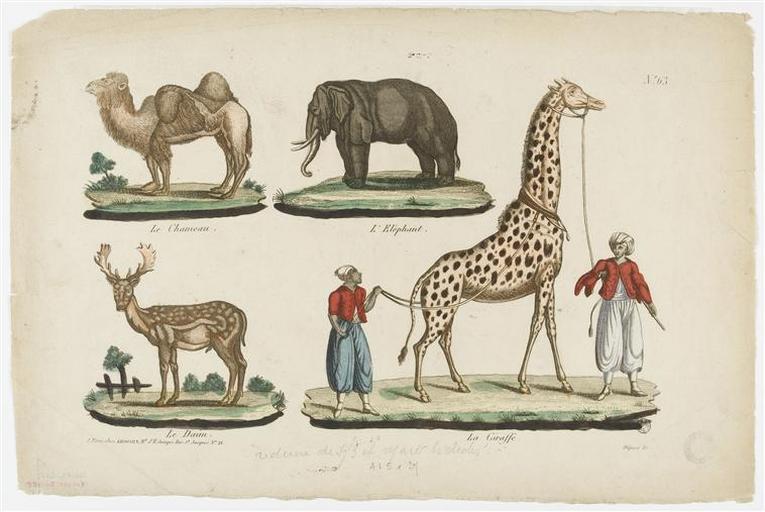
This week’s blog is dedicated to my daughter, who first told me all about the first giraffe in Paris.

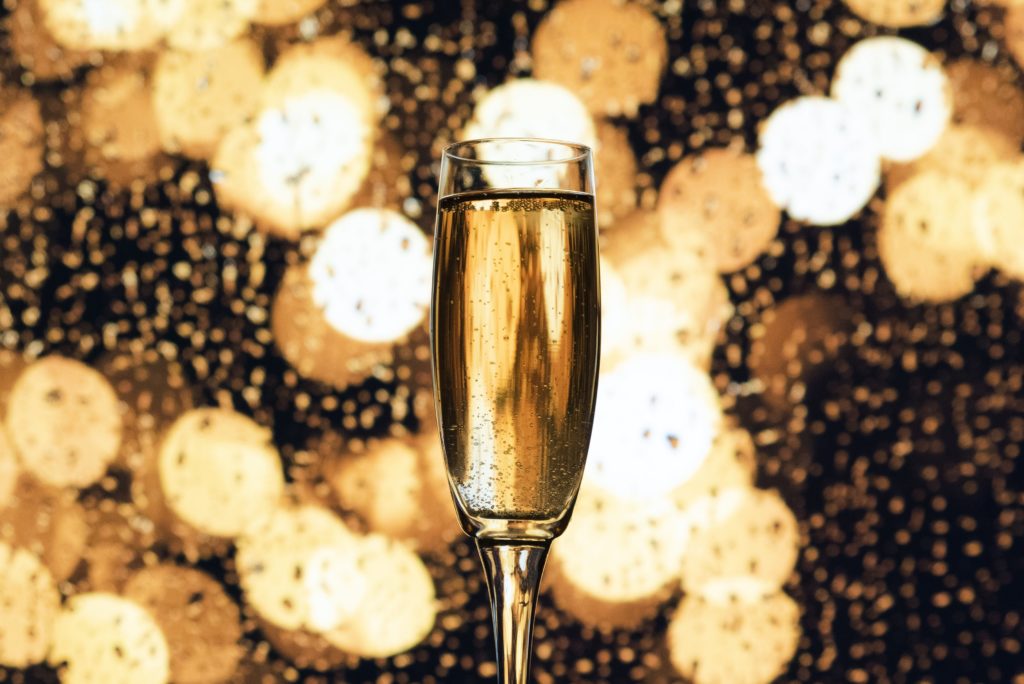
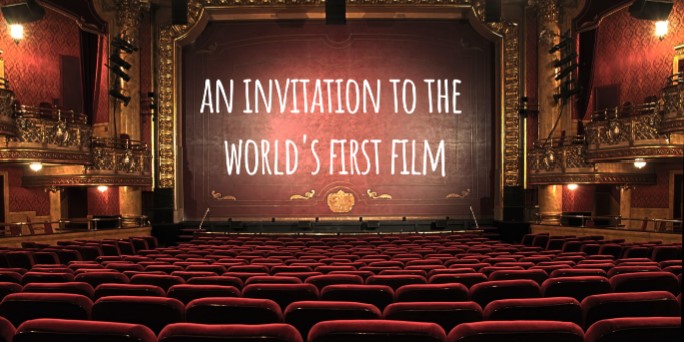

Absolutely love this – I’ve been meaning to write about it for ages, ever since I saw a collection of memorabilia in a castle in the Jura – but I couldn’t write it better than this! Super…
What a lovely thing to say, thank you. I really enjoyed writing this article. Giraffe merchandise was a big thing in 1827, plenty of dresses and plates to be had!
Lovely, well written article. So little was known of the world back then: everything must have seemed so exotic.
It must have been an enormous shock coming across a giraffe for the first time!